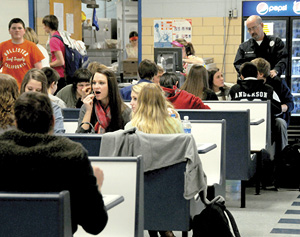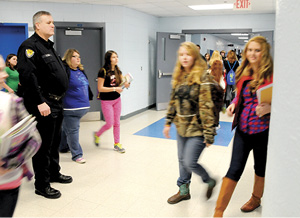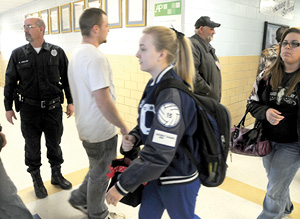Safety of students is focus of officers in Clinton schools

Gun control … school shootings … children being injured and killed … It’s reported all over the news these days and with the recent events at Sandy Hook Elementary School in Newtown, Connecticut, community residents and especially parents are wondering if students really are safe at school?
In recent years, students here in Clinton County have seen police officers roaming their halls. Mike Sinclair, Director of Clinton County Schools Police Department, has been in his position for the past five years and has been a law enforcement officer since 1996.
He said it’s his duty to keep the students safe and he has a responsibility to make the students and parents feel safe inside the schools at Clinton County.
Clinton County is one of only 10 schools in the state with its own police department.
Sinclair said there is more paper work involved, including establishing the department through the Kentucky State Police.
“We are an agency just like the city and the Sheriff’s Department, but we are commissioned through the justice commission in Frankfort, Kentucky,” Sinclair said.
The Albany Police Department, as well as the Clinton County Sheriff’s Department, has been called to serve as SROs (School Resource Officers) to the schools in recent years, but now, Sinclair, along with Police Officer Wayne Conn, spend their days keeping students at all schools safe during and after school hours with the school’s own trained and armed police department.
Conn has been a police officer for the past 18 years. He first started in Clinton County while working at Transcare Ambulance Service. Conn said he was approached by former Chief of Police Raymond Shelton and was asked to give policing a try.
Conn was also a member of the National Guard and has one deployment oversees under his belt.
“I have training in the military and medical training through the EMS and while I was in the National Guard at Fort Campbell, they trained me as a combat lifesaver,” Conn said. “Three years ago, while I was working at the Wayne County Sheriff’s Department, the school contacted me and said they had an opening for a police officer for their agency they had started here.”
Conn said over the past several years, they have made the teachers aware of what can happen in this day in time.
“We hope that nothing ever does happen, but we make them aware of what could happen,” Conn said. “The event that happened in Connecticut, they really came to us and asked what they could do as teachers and parents. I think a lot of the community didn’t really know if they wanted us here or not, but after the Connecticut tragedy, they are appreciative that we are here to protect their kids.”
Keeping students safe is one objective, but making students and parents feel safe is also in their job description.
“There has to be a comfort level just seeing someone here,” Sinclair said. “I know if I was a parent dropping a child off I would feel better seeing a uniformed officer in the school.”
Sinclair mainly stays at the high school while Conn is stationed at the middle school.
Sinclair said his day usually starts around 6 a.m. by turning on the lights and checking doors.
“Sometimes children get dropped off at 6 o’clock in the morning. Some of the parents have to go to work and they bring them in,” Sinclair said. “Throughout the day I try to provide any type of assistance I can to anyone. Most of the time my duties are outside law enforcement … you’re just there to help out, but when an issue does come about, you put your police hat back on and take care of it.”
In addition to regular school hours, Sinclair and Conn also attend many after school events including basketball games, football games and other events that take place after the final bell rings at the end of class schedules.
“There is no way we can be at all the games, but mostly the varsity games or tournaments or a smaller game with a rival school are the ones we attend,” Sinclair said. “We would like to be at all of them, but there is so much that goes on after school.”
At all schools, all doors are locked and deny entry to outsiders, however, to keep up with the fire code, all doors can be opened from the inside at all times.
New to the high school is a card key swipe that allows a limited access to school staff only.
If the school wants to limit a coach or teacher to only being able to access the school during certain hours, the key card can be programmed in that manner. It also allows Sinclair and Conn to monitor each door and both can connect a computer to the door and tell when a particular person entered the school.
“It’s been years since these locks have been changed and now we have it done,” Sinclair said. “It makes it real nice. Then again, I don’t think it’s enough. I don’t think you can have enough security. I would love to see one officer at each school … maybe even two at the high school and middle school, but it’s just not feasible. There is no funding for it.”
In addition to the locked doors and key cards, cameras are also used to see into almost every corner in the buildings.
“I use the cameras everyday,” Sinclair said. “The cameras are motion censored, so when the camera comes on, it’s picked up something. Cameras are no good if you don’t have someone monitoring them.”
Sinclair said he and Conn try to keep the operating cost down to a bear minimum by buying their own uniforms and using their own vehicles.
“It’s crunch time and budgets are tight,” Sinclair said. “It’s the community’s responsibility to see to it their children are in a safe environment. Even if it means volunteering.”
With the majority of Sinclair’s time being spent at the high school, he said he does try to get around to the other schools in the district.
“I feel like there is a greater threat there (at the high school) because we have adults at this school,” Sinclair said. “They aren’t children … they are adults capable of anything. We talk about our first responders … Wayne and I are the first responders. There isn’t anyone who knows these children and these buildings any better than we do. In reality, if you look at a disaster, and you call to get people together, how long would it take to even get a team together to clear a building? It could be an hour.”
Sinclair and Conn both said they have great relationships with the students. In order to make them feel safe, they try to engage in conversation with the students.
“I have a great relationship with all of them. I make it a point to speak to everyone I meet in the hallway,” Sinclair said. “If I don’t engage them in a conversation, they won’t engage back. You have to talk to them and give them that level of comfort.”
“I get up and talk with the kids during lunch,” Conn said. “I will find a table and sit down with them.”
Sinclair said he told his wife, Tonya, he has 400 plus children at the school that are his.
Clinton County schools have utilized grant money in the past to update equipment, like cameras, and according to Sinclair, grant money is available to help start an agency, but not much money is available to help run an existing agency.
“The hard part is not getting an agency, it’s maintaining an agency,” Sinclair said. “There are grants out there and they are great, but most of them are for if you don’t have an agency. They will help start one, but they don’t sustain one.”
At the beginning of each school year, Conn said he has a meeting with all the teachers and each class, fifth through eighth, and goes over any new rules that may have come about during the summer months.
Conn said when the fifth graders get to the middle school, it’s close to the first time they’ve had an officer in the school. It takes them a while to get used to the officer, but as the school year goes on, they get more comfortable.
“I sit down with them and get down on their level,” Conn said. “Now when I come in morning they are giving me hugs and high fives and shake my hand, so they really like us being here. I think they feel safer and I want to make them feel safer.”
Most of the time, the rules don’t change, but one rule Conn likes to retouch every year is students are not allowed to open any of the doors for anybody who is outside.
“If a teacher is outside, then they should have a key to get in. There is no reason for any of them to open the doors from the inside,” Conn said.
Sinclair said he goes over rules in the same fashion, but with the high school students, they are more mature and have been going to school for eight years when they arrive as freshmen.
“They know the rules. They know what to expect and they know about bullying,” Sinclair said. “They are pretty well aware by the time they get here.”
Sinclair said the job both he and Conn do, have to be approached differently.
“Over there, they are children and starting to mature,” Sinclair said. “Over here, their adult minds are getting set in place … you have to handle them differently. If you treat them with respect you will get the truth and you will get to maintain that relationship.”
The relationships Sinclair has made gives him a special insight if a situation was to come about at the high school.
To become a school police officer, Conn said other than going through the police academy, background checks have to be completed and you have to work a minimum of one year inside a police agency like the Albany City Police of the Clinton County Sheriff’s Department.
“I have had SRO training and advanced SRO training,” Conn said. “You can’t hire someone off the street to be a police officer. There are state guidelines that say you have to be a certified police officer at an agency for one year before you can even apply.”
Even though a serious situation has not happened at any school in Clinton County, if something were to happen, Sinclair and Conn would be the first line of defense.
“We will be the ones telling other police officers which door to come to, where the threat is … that sort of thing,” Conn said. “All our doors and windows are numbered, so we can tell EMS or firefighters where they need to go.”
Conn said both he and Sinclair are in contact with the outside agencies in the county and all are very responsive to having police officers inside the school.
“I can get on the radio at anytime and call somebody and they will be here in 10 minutes,” Conn said. “I’ve never had a problem at all with them coming. They give me information, and sometimes I give them information on a case they may be working … it works.”
It’s clear Sinclair and Conn take a lot of pride in their jobs. Their main priority is the wellfare of the students in Clinton County.
“I have dealt with just about every situation possible with these kids,” Sinclair said. “These kids are my priority. You know how important you are because when I see these kids outside of school, they will go out of their way to visit with me. As long as Wayne keeps a real good rapport over there, they come over here and I pick it back up.”


With the safety of students on the minds of residents in communities across this nation, officials with the Clinton County Schools hope the precautions taken in local schools will set both students and parents minds’ more at ease. In the two photos above, officers Wayne Conn, top photo, and Mike Sinclair, above, are shown watching students move through the halls during a class change period.



